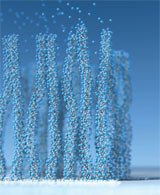In 1995, a small fleet of innovative electric buses began running along 15-minute routes through a park at the northern end of Moscow. A decade later, a few dozen seaport cranes in Asia, a couple of light-rail trains in Europe, and a battalion of garbage trucks in the United States have joined their high-tech ranks.
Because no chemical reaction is involved, ultracapacitors—also known as supercapacitors and double-layer capacitors—are much more effective at rapid, regenerative energy storage than chemical batteries are. What's more, rechargeable batteries usually degrade within a few thousand charge-discharge cycles. In a given year, a light-rail vehicle might go through as many as 300 000 charging cycles, which is far more than a battery can handle. (Although flywheel energy-storage systems can be used to get around that difficulty, a heavy and complicated transmission system is needed to transfer the energy.)
The synergy between batteries and capacitors—two of the sturdiest and oldest components of electrical engineering—has been growing, to the point where ultracapacitors may soon be almost as indispensable to portable electricity as batteries are now.
Ultracapacitors are being explored as replacements for the batteries in hybrid cars. In ordinary cars, they could help level the load on the battery by powering acceleration and recovering energy during braking. Most deadly to the life of a battery are the moments when it is subjected to high-current pulses and charged or discharged too quickly. Conveniently, delivering or accepting power during short-duration events is the ultracapacitor's strongest suit. And because capacitors function well in temperatures as low as –40 ºC, they can give electric cars a boost in cold weather, when batteries are at their worst.
Commercially available ultracapacitors already address those needs to some extent and can provide many times the power of batteries of the same weight or size. But in terms of the amount of energy they can hold, ultracapacitors lag far behind. The major difference is that batteries store energy in the bulk of their material, whereas all forms of capacitors store energy only on the surface of a material. Like a battery, an ultracapacitor is filled with an ionic solution—an electrolyte—and its current collectors attach to the electrodes and conduct current to and from them. The collectors are coated with a thin film of activated carbon that has orders of magnitude more surface area than ordinary capacitors. The amount of surface area in ultracapacitor designs has so far been constrained by the limitations in the porosity of the activated carbon.
The innovation that John Kassakian and Riccardo Signorelli have pursued at MIT is to replace the activated carbon with a dense, microscopic forest of carbon nanotubes that is grown directly on the surface of the current collector. They think that by doing so, they can create a device that can hold up to 50 percent as much electrical energy as a comparably sized battery. This feat would allow ultracapacitors to supplant batteries in a number of mainstream applications. Read

